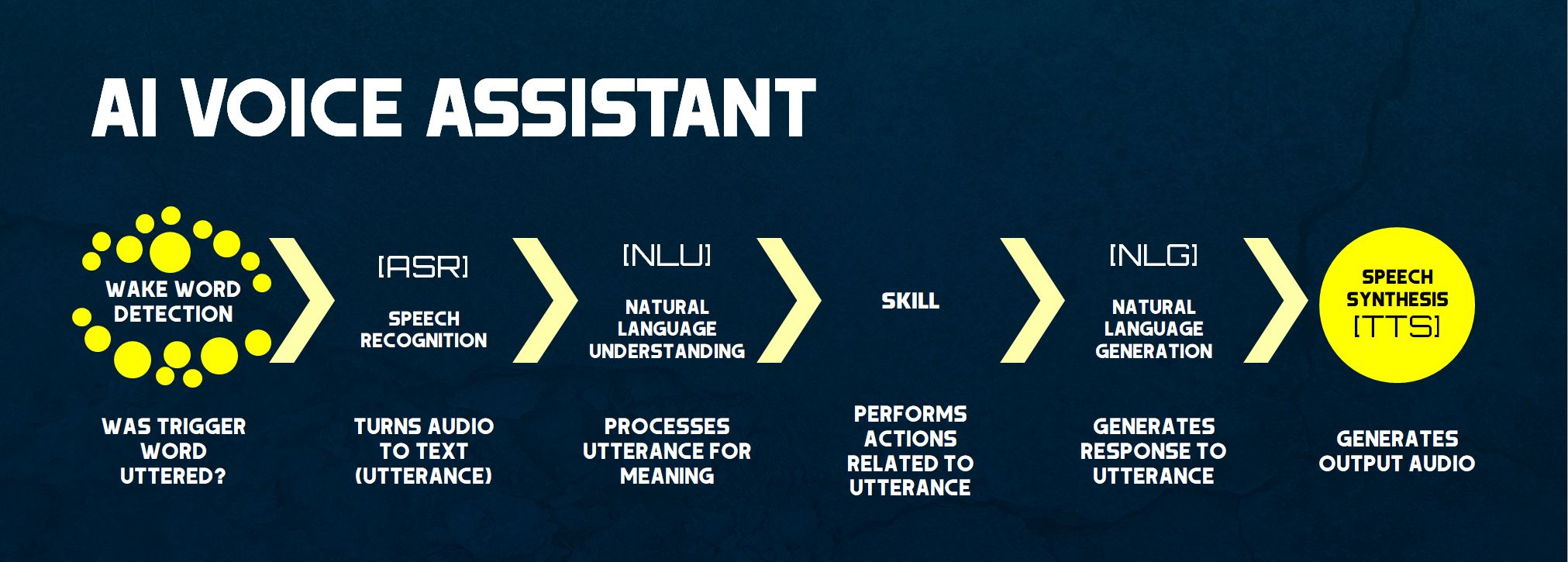GLaDOS Voice Assistant
 |
DIY Voice Assistant based on the GLaDOS character from Portal video game series.
Featured on: |
Read project article first!
Description
- Written mostly in Python
- Work in progress
- YouTube
📺 GLaDOS Voice Assistant | Introduction - YouTube
📺 GLaDOS Voice Assistant | Software - Python tutorial - Twitter
🛠 GLaDOS Voice Assistant project build
Main features
- Local Trigger word detection using PocketSphinx
- Local GLaDOS Text-to-Speech engine using glados-tts model by R2D2FISH
- Speech-to-text processing using Google's API (for now)
- Local TTS cache of generated common audio samples locally for instant answers in the future
- Animatronic eye control using servos
- Round LCD for an eye to display display textures
Tight integration with Home Assistant's local API:
- Send commands to Home Assistant
- Read and speak sensor data
- Notification API, so Home Assistant can speak out notifications through GLaDOS
What it can do:
- Clock
- Control lights and devices
- Weather and forecast
- Add things to shopping list
- Read sensor information
- Random magic 8-ball answers
- Tell jokes
- Judge you and be mean
- Advanced fat-shaming
- Log stuff and gather training data locally
Note: The code is provided as reference only.
Voice Assistant pipeline overview
Requirements for Ubuntu
Install tools
sudo apt-get update
sudo apt-get upgrade
sudo apt install python3-pipInstall PyAudio
PyAudio is needed to play audio files.
sudo apt-get install portaudio19-dev Install PocketSphinx
Used for trigger word detection for now.
sudo apt-get install -y build-essential swig libpulse-dev libasound2-devInstall SpeechRecognition
Used to turn audio into text for now.
sudo apt-get install flacInstall other libraries
Install python modules from requirements.txt file
cd ~/glados-voice-assistant
sudo pip3 install -r requirements.txtInstall pytorch
See here: https://pytorch.org/get-started/locally/#start-locally
Install GLaDOS Voice Assistant
1. Go to home folder
cd ~2. Download the source from GitHub
This will download GLaDOS Voice Assistant and the TTS submodule.
git clone --recurse-submodules https://github.com/nerdaxic/glados-voice-assistant/After this you can play around with the TTS, this works as stand-alone.
cd ~/glados-voice-assistant/glados_tts/
python3 glados.py3. Edit the settings file
Find the sound card ID:
python3 -m sounddeviceGenerate and edit the settings.env file:
cp ~/glados-voice-assistant/settings.env.sample ~/glados-voice-assistant/settings.env && nano ~/glados-voice-assistant/settings.env4. To run:
Launch the voice assistant:
python3 ~/glados-voice-assistant/glados.pyYou can add glados.py to your crontab file or run it manually.
crontab -e
@reboot python3 /home/username/glados-voice-assistant/glados.pyIntegrate to Home Assistant
To make Home Assistant integration work, you need to enable the API in the home assistant configuration file and generate a long-lived access token. Add access token and IP-address of the home assistant server into the settings.env file.
configuration.yaml
# This will enable rest api
api:
# This will add GLaDOS as a notification provider. Replace with correct IP of GLaDOS.
notify:
- name: glados
platform: rest
resource: http://192.168.1.XXX:5000/notifyHardware
List of reference hardware what nerdaxic is developing on, models might not need to be exact. Not a full bill of materials.
| Item | Description |
|---|---|
| Main board | Basic i7 laptop with 16 gigs of RAM |
| Operating system | ubuntu-20.04.3-desktop-amd64 |
| Microcontroller | Teensy 4, to control the eye LCD and NeoPixels |
| Eye lights | Adafruit NeoPixel Diffused 5mm Through-Hole for the "REC" light |
| Eye lights | Adafruit 16 x 5050 NeoPixel Ring |
| Eye LCD | 1.28 Inch TFT LCD Display Module Round, GC9A01 Driver SPI Interface 240 x 240 |
Audio
Audio amp is powered from Raspberry GPIO 5V line and ReSpeaker board from USB to avoid ground loops and noise issues.
| Item | Description |
|---|---|
| Audio amplifier | Adafruit Stereo 3.7W Class D Audio Amplifier |
| Speakers | Visaton FRS 7 |
| Microphone & Audio interface | ReSpeaker Mic Array V2.0 |
Mechanics
Mechanics are powered from their own power supply to allow more power for the servos and prevent brown-outs.
| Item | Description |
|---|---|
| Power supply | MeanWell LRS-50-5 5V |
| Servo controller | Pololu Micro Maestro |
| Servo: Eye movement | 35 kg DS3235 (Control Angle 180) |
| Servo: Eyelids | 25 kg DS3225 (Control Angle 180) |
| Screws | Various M3 and M4 screws |
| Jumper wires | 0.32 mm²/22 AWG assortment |
